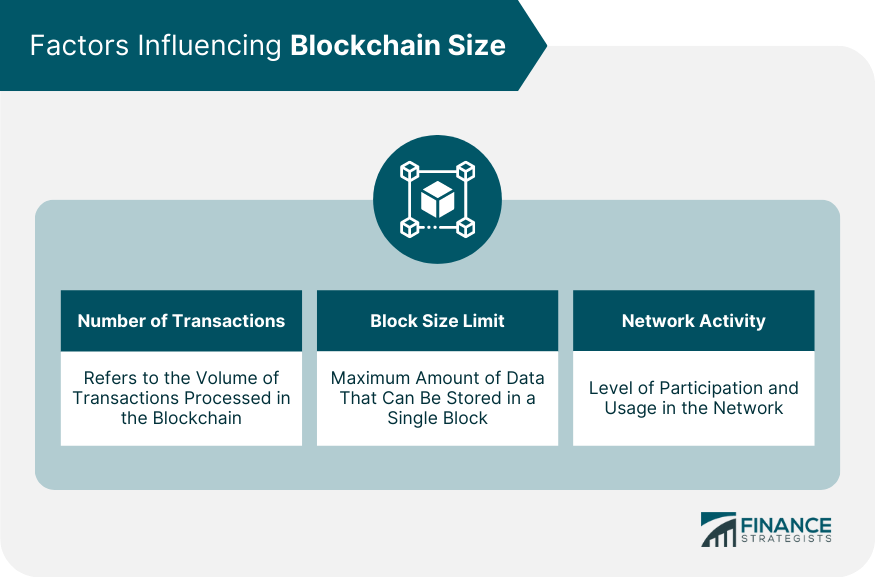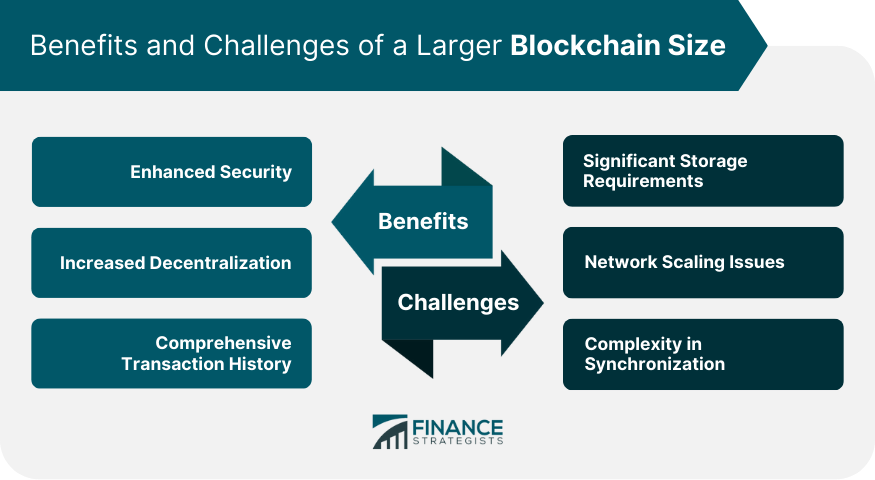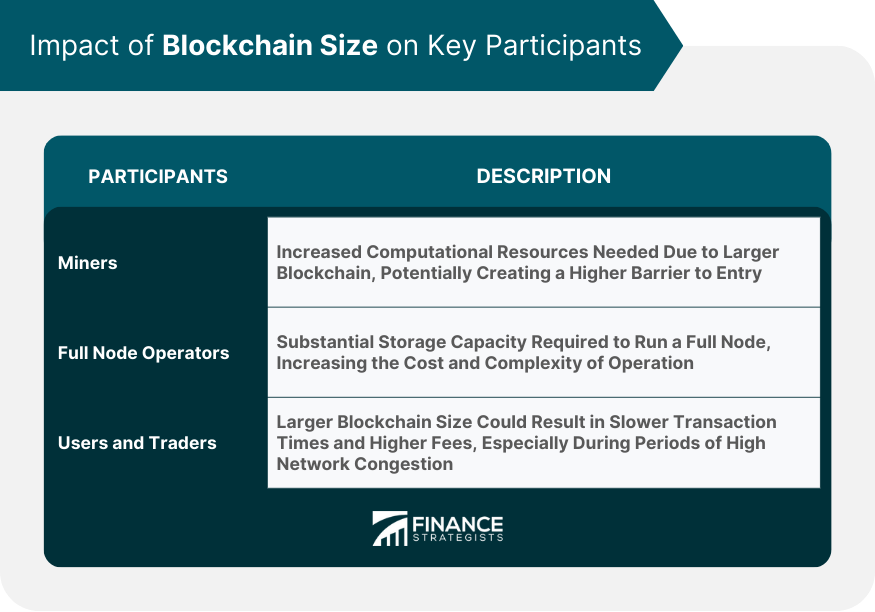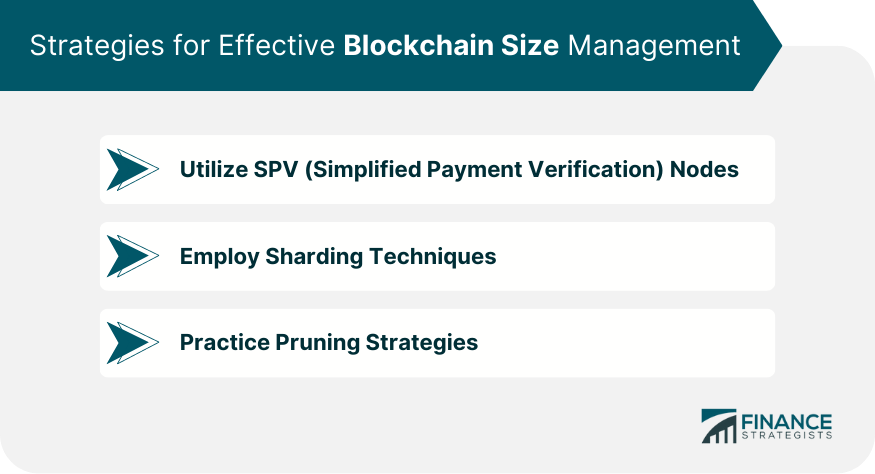Blockchain size refers to the total size of all blocks within a blockchain, where each block is a permanent record of transactions. In the case of Bitcoin, for example, the size of the blockchain reflects every transaction ever made in the network since its inception. The size of a blockchain is a significant factor because it affects various aspects of a blockchain network's operations. For one, it determines storage requirements for running a full node—servers that maintain a copy of the entire blockchain and validate all transactions. It also influences network performance, scalability, security, and decentralization. Understanding blockchain size is thus crucial for users, developers, and miners. The number of transactions processed within a blockchain directly influences its size. A higher number of transactions results in more data being added to the blockchain, increasing its size. Block size limit is a factor that indirectly affects the blockchain size. For example, Bitcoin has a block size limit, meaning each block can only contain a specific amount of transaction data. Larger block size limits allow for more transactions per block, potentially leading to faster growth of the blockchain size. The level of network activity also influences the size of the blockchain. More active networks with a larger number of participants typically experience more transactions, leading to a quicker growth in blockchain size. One of the main benefits of a larger blockchain size is enhanced security. The more blocks in a blockchain, the harder it is for malicious actors to alter past transaction records, as they would need to overwrite more blocks. This characteristic, known as immutability, is one of the fundamental attributes that make blockchains secure. A larger blockchain size also contributes to increased decentralization. As the blockchain grows, so too does the distribution of transaction records across the network. This distribution mitigates the risk of a single point of failure and increases the network's resilience against attacks. A large blockchain size ensures a more comprehensive transaction history. The entire history of transactions is recorded on the blockchain, providing a transparent and immutable record. This can be beneficial for auditing and accountability purposes. The most apparent challenge of a large blockchain size is the significant storage requirement. Full nodes must store the entire blockchain, and as the blockchain size increases, so does the demand for storage space. This can be costly and may discourage the operation of full nodes, impacting the network's decentralization. Large blockchains can lead to network scaling issues. As more transactions are added, it takes longer to process and validate new blocks. This can slow down transaction speeds and reduce the efficiency of the network, leading to scalability issues. A larger blockchain size can complicate the synchronization process for nodes joining the network, known as Initial Block Download (IBD). This process involves downloading the entire blockchain from the genesis block to the most recent one. The larger the blockchain, the longer this process takes, potentially deterring new participants from joining. For miners, a larger blockchain size could mean increased competition, as more transactions could lead to more mining opportunities. However, the large size could also increase the computational resources needed for mining, potentially creating a higher entry barrier for miners. The impact on full node operators is predominantly related to storage requirements. Running a full node for a blockchain with a large size requires substantial storage capacity, which could increase the cost and complexity of operating a full node. Consequently, this could lead to a decrease in the number of full nodes, negatively impacting the network's decentralization. For users and traders, a large blockchain size can affect transaction times and fees. As the blockchain grows, the time it takes to validate transactions can increase, potentially leading to slower transaction times. Additionally, larger blockchains can result in higher transaction fees, especially during periods of high network congestion. Lightweight or SPV nodes offer one solution to managing blockchain size. Instead of storing the entire blockchain, these nodes only store the headers of the blocks. This significantly reduces the storage requirements and allows users to transact without having to download the full blockchain. Sharding is another technique for managing blockchain size. It involves splitting the entire blockchain into smaller, more manageable parts called 'shards'. Each shard contains its own independent state and transaction history, which allows the network to process transactions in parallel, reducing the burden on any single node. Pruning strategies offer another solution to manage blockchain size. Pruning involves removing unnecessary data from stored blocks without affecting the blockchain's integrity. This can significantly reduce the storage requirements for full nodes. The size of a blockchain is a crucial factor that impacts various aspects of network operations. Factors such as the number of transactions, block size limit, and network activity influence the blockchain size. A larger blockchain size offers benefits such as enhanced security, increased decentralization, and comprehensive transaction history. However, it also presents challenges, including significant storage requirements, network scaling issues, and complexity in synchronization. The impact of blockchain size varies for key participants such as miners, full node operators, and users/traders, affecting competition, storage costs, transaction times, and fees. Effective management strategies for blockchain size include utilizing lightweight or SPV nodes, employing sharding techniques, and practicing pruning strategies to reduce storage requirements without compromising the integrity of the blockchain. By understanding the significance of blockchain size and implementing appropriate management strategies, stakeholders can navigate the challenges and leverage the benefits of blockchain technology.What Is Blockchain Size?
Factors Influencing Blockchain Size
Number of Transactions
Block Size Limit
Network Activity

Benefits of a Larger Blockchain Size
Enhanced Security
Increased Decentralization
Comprehensive Transaction History
Challenges of Large Blockchain Size
Significant Storage Requirements
Network Scaling Issues
Complexity in Synchronization and Initial Block Download (IBD)

Impact of Blockchain Size on Key Participants
Miners
Full Node Operators
Users and Traders

Strategies for Effective Blockchain Size Management
Utilizing Lightweight or SPV (Simplified Payment Verification) Nodes
Employing Sharding Techniques
Practicing Pruning Strategies

Conclusion
Blockchain Size FAQs
Blockchain size refers to the total size of all the blocks in a blockchain. Each block represents a record of transactions, so the blockchain size effectively represents the total volume of transaction data in a blockchain network since its inception.
The blockchain size increases with the addition of new blocks to the chain. Each block contains a set of transactions. Therefore, as more transactions are processed in the network, more blocks are added, leading to an increase in the blockchain size.
A larger blockchain size enhances security through the principle of immutability. The more blocks in the blockchain, the harder it is for an attacker to alter past transactions, as they would need to overwrite more blocks. This enhanced security comes from the increased complexity and computational power required to modify a larger blockchain.
A large blockchain size presents several challenges, including significant storage requirements, network scaling issues, and a complex synchronization process. These factors can affect the efficiency of transactions, the cost and feasibility of running a full node, and the speed at which new nodes can join the network.
Several strategies can be employed to manage blockchain size effectively. These include using Lightweight or SPV (Simplified Payment Verification) nodes, employing sharding techniques, and practicing pruning strategies. These methods help reduce storage requirements and improve the scalability of the blockchain network.
True Tamplin is a published author, public speaker, CEO of UpDigital, and founder of Finance Strategists.
True is a Certified Educator in Personal Finance (CEPF®), author of The Handy Financial Ratios Guide, a member of the Society for Advancing Business Editing and Writing, contributes to his financial education site, Finance Strategists, and has spoken to various financial communities such as the CFA Institute, as well as university students like his Alma mater, Biola University, where he received a bachelor of science in business and data analytics.
To learn more about True, visit his personal website or view his author profiles on Amazon, Nasdaq and Forbes.













